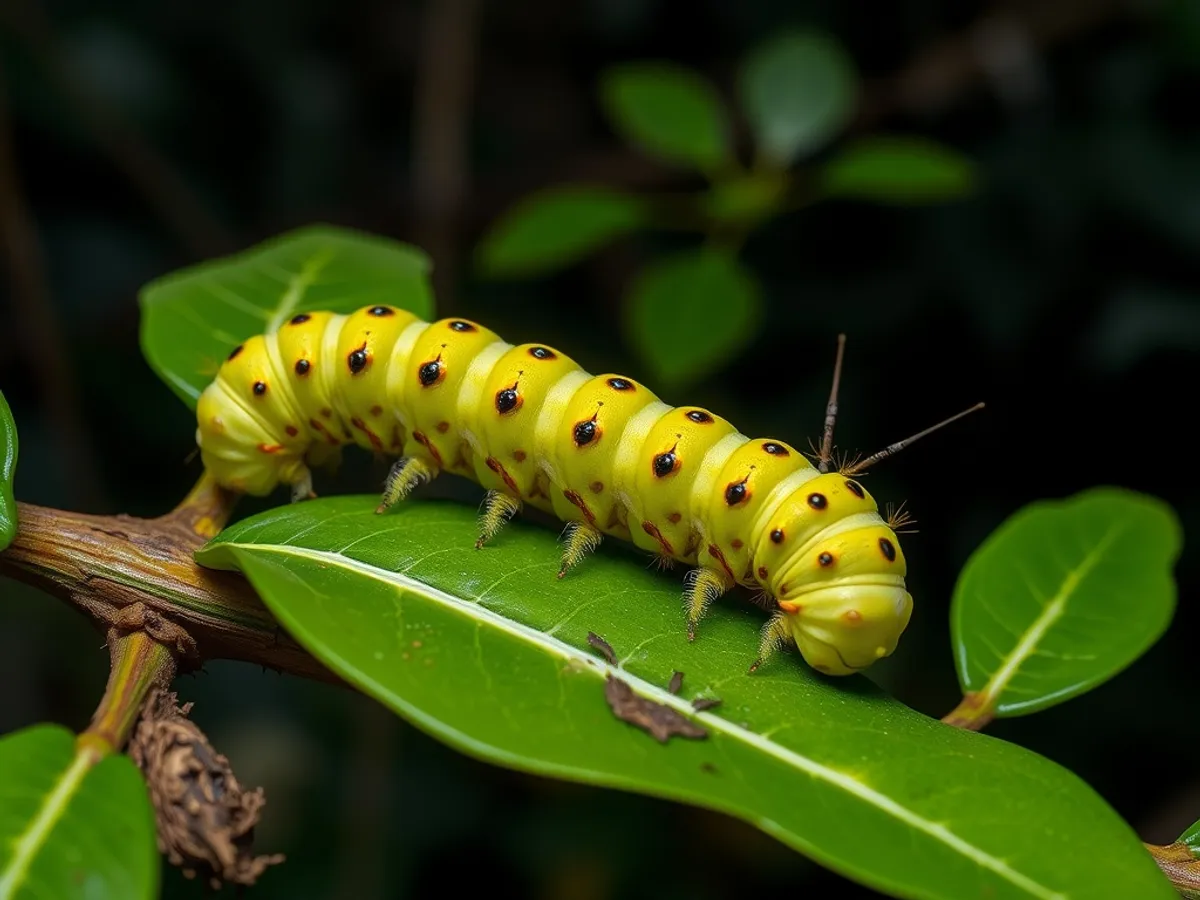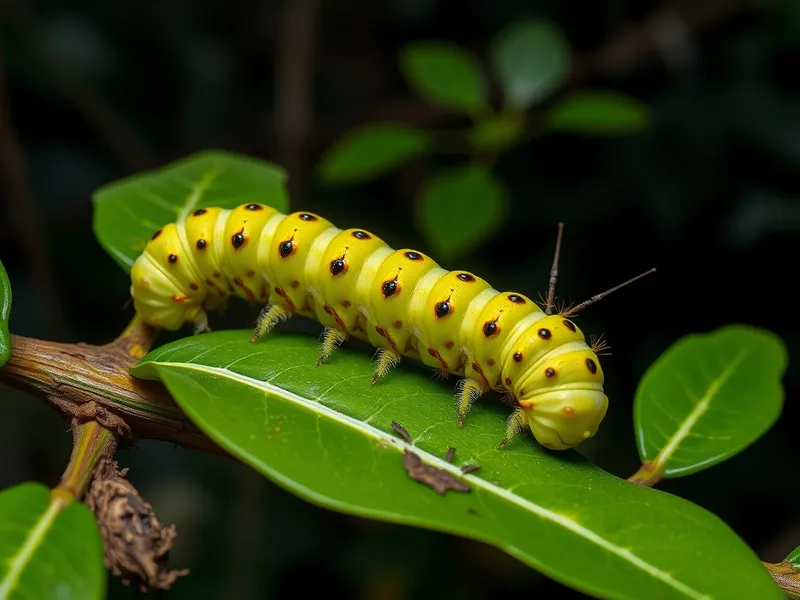
Atlas moth caterpillar
Attacus atlas

Meet the Atlas moth caterpillar
The Atlas moth caterpillar is the larval stage of the Atlas moth, one of the largest moth species in the world. These caterpillars are strikingly pale green to bluish-green, adorned with white, waxy spines along their bodies and a plump, segmented appearance. They feed voraciously on the leaves of a variety of trees and shrubs, storing up nutrients for their dramatic transformation into adult moths. Native to the tropical and subtropical forests of Southeast Asia, the Atlas moth caterpillar plays a vital role in the life cycle of this iconic invertebrate.
Classification
Invertebrate
Habitat
Tropical and subtropical forests
Diet
Herbivore
Lifespan
4-5 weeks (larval stage)
Conservation
Least Concern
Weight
15-18 grams
📖Fascinating Facts
Record Size
Atlas moth caterpillars are among the biggest caterpillars in the world, sometimes exceeding 11.5 cm in length.
Leaf Lovers
They feed on a variety of host plants, including citrus, guava, cinnamon, and cherry trees.
Protective Wax
The white, waxy coating on their bodies is believed to make them less palatable to predators and help prevent dehydration.
📋Detailed Description
The Atlas moth caterpillar (Attacus atlas) is a robust larva, reaching lengths of up to 115 mm (4.5 inches) and a diameter of about 25 mm (1 inch) at its largest instar. Its body is a striking pale green to bluish-green, covered in distinctive white, waxy tubercles that secrete a powdery substance, likely serving as a deterrent to predators and parasites. The caterpillar’s head is large and brownish, equipped with strong mandibles for efficiently consuming tough, fibrous leaves. Along its dorsal surface, the caterpillar displays a series of fleshy, spine-like protuberances, which are more pronounced in later instars. The ventral surface is smoother and paler, with prolegs that provide strong grip on branches and leaves. Atlas moth caterpillars are solitary feeders, typically found on the undersides of leaves where they are less visible to predators. They undergo five to six molts (instars) over a period of 3–4 weeks, during which they can increase their body mass by more than 10,000-fold. Prior to pupation, the caterpillar ceases feeding and spins a dense, silken cocoon, often incorporating leaves for camouflage. The larval stage is critical for nutrient accumulation, as the adult moths do not feed and rely entirely on reserves built up during this period. Their coloration and waxy secretions provide both camouflage and chemical defense, making them less palatable to birds and ants.
💡 Did you know?
Despite their size and voracious appetite, Atlas moth caterpillars are harmless to humans and do not sting or bite.
🔬Research & Sources
🎭Behavior & Social Structure
Atlas moth caterpillars are primarily nocturnal feeders, emerging at dusk to consume large quantities of foliage from host plants such as cinnamon (Cinnamomum), guava (Psidium), and citrus (Citrus spp.). They exhibit a sedentary lifestyle, remaining on a single host plant throughout their larval development unless food becomes scarce. The caterpillars are solitary and display minimal social interaction, except for occasional aggregation during the early instars when eggs are laid in clusters. When threatened, the caterpillar may rear up and display its waxy tubercles, sometimes exuding droplets of fluid as a deterrent. Their feeding behavior is methodical, often stripping entire leaves before moving to the next. During the day, they remain motionless on the underside of leaves, relying on their coloration and waxy coating for concealment. Molting occurs at regular intervals, during which the caterpillar becomes inactive and vulnerable.
👶Reproduction & Life Cycle
Reproduction in Attacus atlas begins with the adult female emitting pheromones to attract males, often from considerable distances. After mating, the female lays 150–200 eggs in clusters on the undersides of suitable host plant leaves. The eggs incubate for 8–14 days, depending on temperature and humidity. Upon hatching, the tiny larvae begin feeding immediately. There is no parental care; all nourishment and protection are self-acquired by the larvae. The breeding season varies geographically but typically coincides with the wet season, when host plants are most abundant. The entire larval stage lasts 3–4 weeks, followed by pupation within a silken cocoon. The pupal stage can last 3–4 weeks, after which the adult moth emerges. In some regions, multiple generations may occur annually.
🛡️Adaptations & Survival
Atlas moth caterpillars exhibit several adaptations for survival. Their waxy, powdery coating deters predation and parasitism by making them slippery and unpalatable. The coloration provides camouflage against foliage, especially in dappled light. The caterpillar’s robust mandibles allow it to consume tough, fibrous leaves, and its rapid growth rate minimizes exposure to predators. The ability to incorporate leaves into their cocoons further enhances pupal camouflage. Physiologically, they can tolerate a range of humidity and temperature conditions typical of tropical forests. The caterpillar’s large size allows for significant nutrient storage, critical for the non-feeding adult stage.
📚Research Sources
🎨Cultural Significance
The Atlas moth and its caterpillar hold significant cultural value in parts of Asia. In India, the silk produced by the cocoon, known as 'fagara' silk, is harvested for local textile production, though it is less commercially valuable than that of the domesticated silkworm. The moth’s impressive size and beauty have made it a symbol of transformation and endurance in folklore and art. In some cultures, the moth is associated with good luck or spiritual messages. Atlas moths are also popular in butterfly houses and educational exhibits worldwide, where their life cycle is used to teach about metamorphosis and biodiversity.
🔬Recent Research & Discoveries
Recent research has focused on the chemical composition of the caterpillar’s waxy secretions, revealing antimicrobial properties that may protect against pathogens. Studies on host plant selection have shown that larvae prefer plants with higher nitrogen content, which supports rapid growth. Genomic analyses are underway to better understand the evolutionary relationships within the Saturniidae family. There is also ongoing research into the potential use of Atlas moth silk for biomaterials, given its unique structural properties. Conservation studies are monitoring the impact of habitat fragmentation on genetic diversity and population connectivity.
🎥Wildlife Videos

the scary face of a giant caterpillar before it becomes a beautiful atlas moth|jump spiders|predator
the scary face of a giant caterpillar before it becomes a beautiful atlas moth|a vicious little predatory jumping spider#insects ...
Local Animals

Atlas Moth - 5 Minute Documentary
Embark on a mesmerizing journey into the world of the Atlas Moth, one of nature's most enchanting spectacles, in a captivating ...
Five Minute Documentaries

Atlas Moth transformation from Caterpillar to Pupa to Moth
Attacus atlas, the Atlas moth, is a large saturniid moth endemic to the forests of Asia. The species was first described by Carl ...
Singapore Geographic

stung by fire ants‼️very scary before it becomes a beautiful atlas moth and catches crickets
very scary before it becomes a beautiful atlas moth and catches crickets and beetles#nature #catching #wildlife #animals #insect ...
Local Animals

Largest Moth in the world - Attacus Atlas Moth
Attacus atlas caterpillar eating avocado leaves,weaving its cocoon until it comes out and become an adult moth. #Moth #nature ...
ArtbyArnel

Watch This Caterpillar Turn Into A Puss Moth | The Dodo
Watch how this tiny little caterpillar transforms into a giant Puss Moth. You can check out more of Adam's work by visiting his ...
The Dodo
🌍Habitat Information
The Atlas moth caterpillar typically inhabits Tropical and subtropical forests environments. Atlas moth caterpillars have adapted to their environments with specialized features and behaviors.
Primary Habitat:
Tropical and subtropical forests
More detailed habitat information will be available soon.
🛡️Conservation Status
The Atlas moth caterpillar is currently classified as Least Concern. Conservation efforts are crucial for preserving this species for future generations.
Common Threats:
- 🏠Habitat loss and fragmentation
- 🌡️Climate change impacts
- 🎯Hunting and poaching
- 🏭Human-wildlife conflict
⚠️Threats & Conservation Challenges
While the Atlas moth is listed as Least Concern, its caterpillars face threats from habitat loss due to deforestation and agricultural expansion in Southeast Asia. Pesticide use in plantations can also reduce larval survival. Natural predators include birds, parasitic wasps, and ants, though the caterpillar’s defenses mitigate some risk. Climate change may alter the phenology of host plants, affecting larval food availability. Despite these challenges, the species remains widespread and adaptable, with stable populations in protected forest areas and even in some cultivated landscapes.
🔬Scientific Classification
Scientific Name
Attacus atlas
Classification Hierarchy
🔍 About Taxonomic Classification
Taxonomic classification is a hierarchical system used by scientists to classify and organize living organisms based on shared characteristics and evolutionary relationships.
The system moves from broad categories (Kingdom) to increasingly specific ones, with each animal's scientific name typically consisting of its Genus and species.
📝Community Notes
Share your observations and insights about the Atlas moth caterpillar with our community of wildlife enthusiasts.
Join Our Community
Sign in to share your observations and connect with fellow wildlife enthusiasts.
Sign In to ContributeNo community notes yet
Be the first to share your observations about the Atlas moth caterpillar!
Explore Atlas moth caterpillar
Select a tab above to learn more about this amazing animal.
📸Photo Gallery
No photos available for this animal yet.
🌟Discover More Wildlife
Continue your journey of discovery with more fascinating animals from our database
